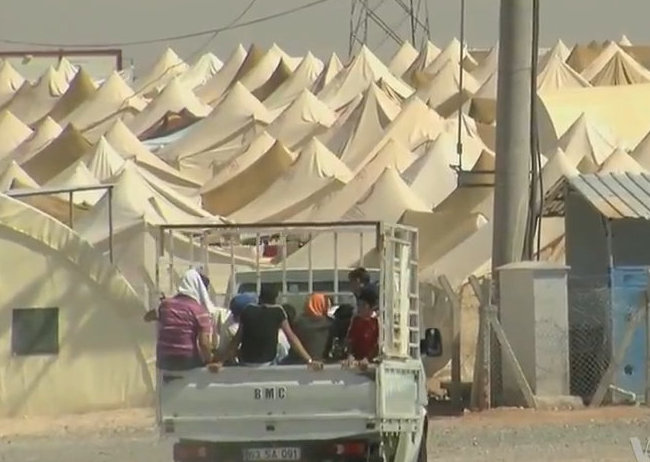
The global migration crisis continues to worsen, with displacement hitting an all-time high of 59.5 million people at the end of 2014. The humanitarian world is unable to keep up with the numbers, as violence and conflict also continues to soar worldwide.
The usual proposed solutions for displacement typically fall into one of three categories: voluntary return to home countries, resettlement to a third country, or integration into the host country. But there are many obstacles that prohibit these traditional forms of aid from materializing into sustainable solutions, including a lack of political will on the part of host countries, donor fatigue, and the lack of security or economic opportunities in home countries that prevent refugee returns. According to a recent IRIN News report, these efforts to help refugees are not durable and proving elusive.
Thinking outside the traditional solutions, a real-estate mogul recently came up with a radical plan to build a new country for all the nearly 60 million displaced worldwide. Jason Buzi’s Refugee Nation aims to provide refugees a state of their own, where they could live in safety and be allowed to work just like everybody else. This business-oriented approach has generated much criticism for being naïve – where would the infrastructure come from for such an ambitious project? But others think it’s a novel idea that has the potential to generate more donor money.
The biggest problem with Refugee Nation is that it fails to acknowledge that refugees are human beings with agency, and actually make independent decisions about when and where they relocate. Many are, of course, fleeing from conflict, political strife, and persecution and are “forced” into their predicament; but in today’s globalized world, displaced people rarely fit into the neat categories of “migrant” or “refugee.” Just because a country is open and available — and Buzi needs to show that this is even feasible — does not mean that it meets the multi-faceted needs of the refugees for which it is meant. We cannot force people to move to an artificial country: If we build it, it does not necessarily mean they will come.
Buzi’s plan also fails to consider the root causes of displacement. What will happen to Refugee Nation’s citizens when war breaks out between diverse ethnicities and religions? Alexander Betts, director of the Refugee Studies Center at Oxford University, questioned Buzi’s rationale by highlighting that artificial nation-building often leads to displacement and violence. It would be hard to imagine people wanting to permanently live in such a place unless it were “more or less utopian,” he said. After all, one could argue that artificial nation-building is an already tried-and-failed experiment; what was colonialism in the African continent or the Middle East if not the contrived drawing of state lines with little consideration of ethnic and religious sensitivities?
To help the globally displaced, we must begin to take into account the rational choices they make, and the many factors that drive those choices. If we can’t stop them from boarding rickety boats headed from Libya to Europe or Myanmar to Thailand, how can we expect to herd people into a newly-created country?
Refugee Movements and Economic Motivations

The distinction between economic migrants and refugees also exacerbates the problem by perpetuating the image of a refugee as only a victim, and not an economic and social actor. The de jure definition of a refugee, as defined by the United Nations (UN) Convention and Protocol, emphasizes “a well-founded fear of persecution.” This qualifying factor becomes problematic, when viewed independent of the state of the global economy. The rigid definition ignores the multiple determinants of population movements, where many factors converge in a person’s decision-making process.
People’s motivations for moving also do not usually fall gracefully into “forced” or “voluntary” categories. There are many in-between classifications, and the same person can be simultaneously fleeing and seeking better opportunities. The push-pull factors of people relocating becomes hard to distinguish.
A central issue in the study of refugee movements is the relationship between economic and political determinants. Anthony H. Richmond, a researcher on the sociological theories of international migration, asserted as early as 1988 that the distinctions between “free” and “forced” or “voluntary” and “involuntary” are misleading. He instead suggests the use of a continuum to better explain migration. At one end, individuals and collectives are proactive in their decision to move, and at the other reactive, or in response to outside factors such as war, violence, persecution, and political strife.
Richmond’s multivariate approach takes into account that population movements are a complex response to the reality of a global society in which ethno-religious, social, economic, and political factors are inextricably bound together.
While looking for plausible solutions for those that have been left without homes, we often forget that refugees have free will. And both refugees and migrants move, where they perceive to have better prospects. The long-term goal for all is security, stability, and some semblance of normalcy.
Asylum-seekers should not be condemned for having preferences about where they would like to seek refuge. And refugees don’t need a new country created for them. Instead, the displaced need to be empowered with the knowledge that the rest of the world sees them as individuals with needs, desires, and hardships, just like everyone else.
